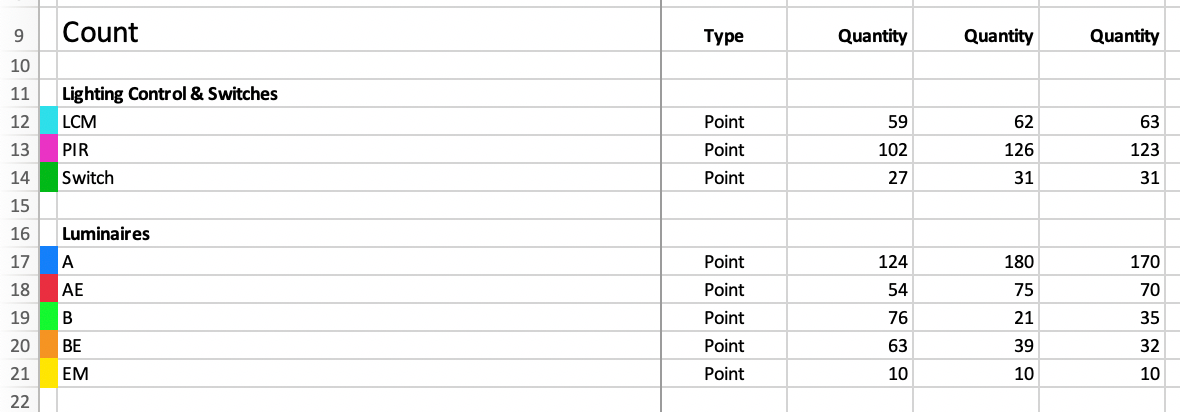
If part of your work involves electrical estimating it’s likely you’ll have come up against a complicated estimating spreadsheet for labour, material and equipment costs. The benefit of using Excel for an estimation project lies within the formulas. By entering different line items for costs you can easily calculate the total cost of each item, and multiply across floors or drawings to calculate estimates faster.
In this blog, we outline the best practices when creating an electrical estimating spreadsheet on Excel, including formulas and functions, as well as the potential downsides to relying on Excel.
You can also download our free customisable Excel estimate template. This template includes itemised sections for listing materials and labour costs. Simply enter your rates and quantities for each item, and the template will automatically total your costs.
How to create an electrical estimating spreadsheet
1. Choose your spreadsheet format
Traditionally, estimating meant using Microsoft Excel to create a spreadsheet on your desktop or server. With the rise of cloud-based tools, today you might use Excel online, which allows you to collaborate with others in an online spreadsheet or Google Sheets which is a similar online tool. Which version you choose will likely depend on your company setup and whether you use Outlook (Microsoft) or Gmail (Google) for your general company email and functions.
Either way, we recommend using a cloud-based version of Excel, which comes with auto-save, different permissions levels and the ability to work within one spreadsheet collaboratively with other colleagues. While working from home, being able to access your spreadsheets for takeoff and estimating will make your project workflow more seamless.
2. Create formulas and functions
Within Excel you have what are called formulas and functions. Formulas are simple equations which let you add, subtract or multiply numbers, for example =B1+B2 which would give you the sum of those two cells.
Functions are preset formulas that Excel can recognise for slightly more complicated actions, like adding all of the items in a row. For example, =SUM(D1:D51) to give you the total of all of your estimating costs in column D.
Here are a couple of simple functions which could come in handy on your estimating project:
- SUM e.g. =SUM(A1:H1) would add all of the items in row 1 across columns A to H. You can also use SUM alongside another formula, for example if you wanted to add up all of your costs and add 20% vat you could use =SUM(H1:H54)*1.2
- AVERAGE e.g. =AVERAGE(H1:H20) would add all of the items in column H and find out the average of those sums. This is useful for working out the average cost if you have slight variations across elements and want to have a more general average cost.
- COUNT e.g. =COUNT(A5:A100) this would count all of numerical values only within column A. This is really useful to circumvent estimating sheets where you may have counts split into sections and notes between sections, but where you still want to create a total number of costs.
3. Organise your spreadsheet
To create a full electrical estimate you’ll likely have a spreadsheet that breaks down all of the project costs. Looking at things like materials, labour costs, equipment and any other line items, for example insurance, travel costs or even PPE.
Some of the tips that we use at Countfire to make the takeoff output spreadsheet as organised as possible include:
- Project overview - Having the first page as a project overview, allowing you to list all of the disciplines you’re accounting for and the number of drawings within each discipline. This is also where you can add any notes or comments to other estimators working within your project as a reference point.
- Disciplines - In most estimating spreadsheets you’ll break down the project by discipline, for example Lighting. Within each discipline you’ll likely have a further breakdown into each area of Lighting, for example a column or section for Lighting Control & Switches and another for Luminaries. You may also want to separate which sections are counted (switches) and which are measured (containment) as the latter will have linear or area measurement rather than an automatic count.
- Summary of totals - in order to transfer accurate takeoffs into your full estimating sheet it’s important to have a summary of totals for each area. This enables you to quickly copy over totals and add in pricing for each. Don’t forget that if you copy grouped data, such as sums, into an unlinked separate spreadsheet you’ll need to copy visible cells only to prevent the total showing as zero.
The downside of using Excel for your takeoffs
Of course, even the fastest Excel whizz may struggle to create a completely accurate estimation in Excel. There’s a margin of human error that comes when manually inputting takeoffs and figures and it can be hard to spot inconsistencies.
Excel also opens the floor for anyone working on any project, to create their own version or make edits which can make it hard to have a consistent process and approach. Excel also isn’t built with estimating in mind, so you’ll be building on basic formulas and functions for even complex calculations and projects and there’s no guidance on how to split your disciplines or project overviews.
The benefit of using takeoff software like Countfire for your estimations is that every element of the project is outputted in a takeoff Excel spreadsheet. This creates the following benefits:
Synergy between your takeoffs and your spreadsheet
When you’re setting up your takeoff in Countfire you’ll upload drawings under category headings for each discipline for example Power & Data, Fire & Security or Lighting. When you then begin to count each symbol, or measure under those disciplines, you’re automatically creating these as pages within your Excel spreadsheet. Once all of your counts are done, the output of your counts is organised into the disciplines and broken down on the spreadsheet by symbol description.
This makes it very easy to keep your drawings, your takeoffs and the resulting spreadsheet aligned and ensure accuracy between counts and disciplines.
Standardised estimating formatting
Each spreadsheet produced within Countfire is organised in the same way, with individual sheets showing your Project Overview, Drawing List (so you can ensure all drawings were accounted for) and an individual sheet for each discipline.

This makes it easy to understand and accurately copy the count of each item into your full estimating Excel spreadsheet.
Ability to make changes
When finalising a project with Countfire there are a series of final checks to make to ensure that you haven’t missed any symbols or created a false positive for a symbol.
If you do happen to find any mistakes you can simply go back and edit the drawings (using the guidance from the spreadsheet which will show you exactly which symbols were counted on which drawing) and reprocess your files.
This makes it much easier to 1) check the accuracy of your counts and 2) make changes without affecting all of the other symbols. When using manual counts or individual Excel spreadsheets which aren’t set out in a specific formula it isn’t possible to spot granular errors which can have a huge impact on your project pricing.
Final thoughts
Excel can be a good starting point when it comes to creating estimation projects but it isn’t the most accurate or efficient way to complete a takeoff or estimate. To create automated takeoffs and receive all of your counts in a single, downloadable spreadsheet, give Countfire a try today.


